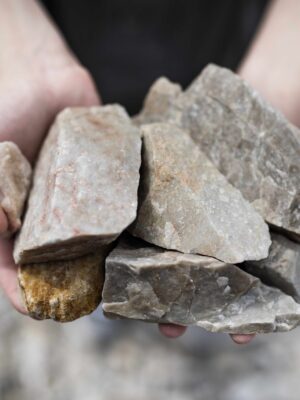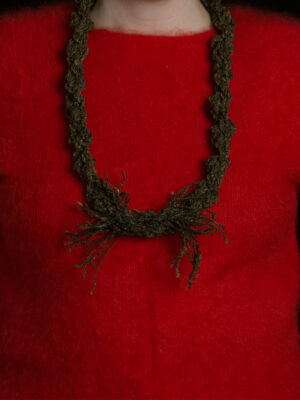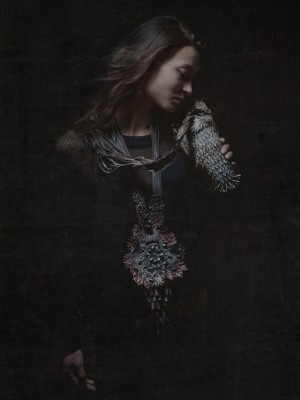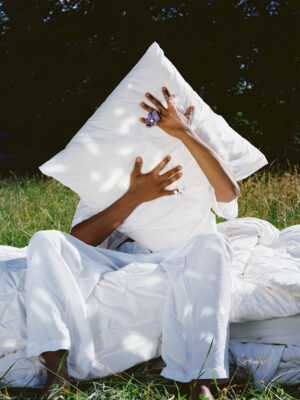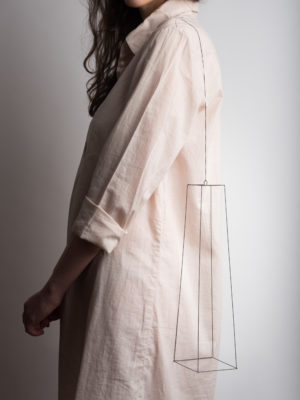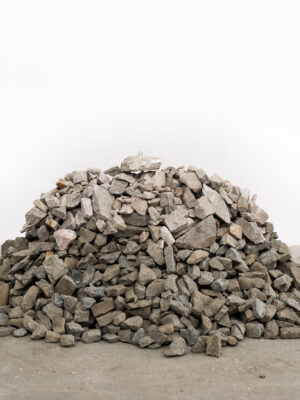
The concept was smart; the execution unassailable. It used the language of jewellery to critique jewellery itself, and the raw physical materiality brought into the gallery, to reflect on our relationship to materials. It also occurred to me that it was the first time I’d seen anyone so clearly question the sad reality of jewellery making, that we all know to be true, but either dance around or disassociate from. At the very least, the material waste that jewellery creates; at worst, the contribution to ecological collapse and systemic labour inequality, in the name of, what by many, is considered to be a luxury item.
It employed no arcane symbolism or obfuscation, because the message was intended to be clear. Unavoidable even. It posed a question that, in its sheer physical presence, refused to go unacknowledged. I came back again and again, to the image, the implications, and a simple, nagging thought. Why are we not talking about this? I learned that after graduating the MA at Royal College of Art, Dettar was on her way to a mining site in Senegal, intending to create work with the toxic byproducts of artisanal mining, something like, vessels made from the toxic clay of riverbeds. But after months of research, weeks of travel and becoming seriously ill in the process, she’d been unable to gain access to even the locations of the mines themselves. For a few years I lost track of her story, but that piece remained in my mind; a gold standard by which I still approach installation work today. And so did the nagging questions.
To be fair, much of contemporary jewellery is centred around exactly this issue. There is no shortage of practitioners working with found objects, recycled or repurposed waste matter, or organic substances hand-processed into a usable material for their work. But let’s be honest: For the seemingly endless conversations in the field questioning ‘value’ and ‘preciousness’, how often do those conversations use words like ‘mercury poisoning’ and ‘child labour’? Complicated as it is, for working jewellers, metal will probably enter the equation at some stage, particularly when, in order to make a living, they face the need to sell ‘commercial’ work, to earn a living. The intervening years, Katharina had spent working first at Gallery SO, and then lecturing at Central Saint Martins, and I reached out to see how she saw things now. I was thrilled to learn that her piece had been acquired by Museum Arnhem, but not before she had installed it no less than 8 separate times at various exhibitions. She could still detail the logistics necessary to lift and transport that much rock, in how many bags of how many kilos, only to learn once or twice that the floor of the space couldn’t even support the weight.
I wanted to know how the story had begun, and we alighted on perhaps the bare essentials of the issue, when she recalled that she’d been working as a goldsmith for almost a decade before one day just asking herself, Where did this come from?
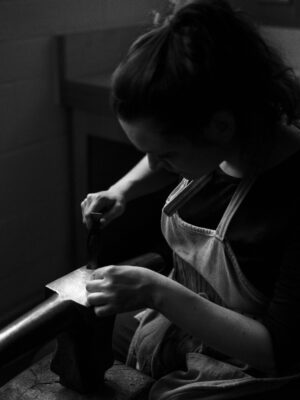
And how did it get here? Such simple questions turned out to be the gateway to sustainable thinking in general. The more shocking realisation to her was that no one else had ever asked her that question either. ’When I worked in the gallery, I can count with my two hands the amount of people who asked me where these materials came from, or if any of these were recycled. And I worked there for three years, four days a week.’
This brought to mind a quote I’d come across in my research, from Richard Fuller, CEO of the Pure Earth initiative, who since 1999 have actively worked to clean up the world’s most polluted areas, and plenty to counteract mining-related pollution. He quite explicitly stated that the obligation now lies with jewellers, to make responsibly sourced gold the norm.
Surely jewellers play a role, but such an emphatic statement immediately made me think of the other half of the equation: namely the consumer, or at least the market. Consider the many jewellers out there trying to earn a living; against the overabundance of cheaply made jewellery readily available, it’s surely diffcult to convince makers to opt for even more expensive materials than they are already using. On the other hand, in Katharina’s own words, ’The moment you begin to research gold, you don’t sleep anymore. You honestly want to stop making,’ which is certainly worse. Seemingly, the question of metal is one we simply can’t ignore, though the consensus on available solutions is scant. So is there a responsible version of gold mining?
When it comes to attempts to regulate the mining industry, paradoxically, the larger organisations are more adept at absorbing new criteria for doing business. But the problems with mining are manifold, whether ecological or social, and most existing regulations cover only one aspect. Or they enforce only voluntary guidelines, not to mention, they extend only the producers that can be seen and accessed for oversight. This leaves a sizable strata of artisanal small-scale mining, which may sound like a sustainable alternative, the oat milk latte version, you might say; but in fact is essentially illegal, unregulated mining, easily the most vulnerable to corruption. And according to the aforementioned PureEarth initiative, it is the leading cause of global mercury emissions. Meanwhile, the fact that so much of this gold is in circulation, black market trade is an absolute certainty. With extraction in the Global South totally invisible for commerce in the Global North, it is these loopholes that allow copious, unchecked amounts of product to be diverted through seemingly responsible schemes, masking gross injustices along the way.
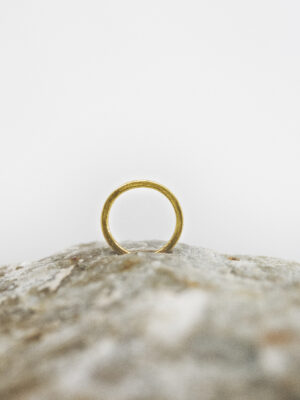
Located in Colombia, the Fairmined label was established first in 2004 by the Alliance for Responsible Mining, to certify gold of responsible origin, and ultimately forged its own path in 2014, as a reaction to the Fairtrade certification, which left several of these loopholes open. Sounds like the same thing, and in fact similarities like these can be confusing to navigate for consumers. But the differences can be significant. As explained to me by Jaime Valderrama, the representative whom I spoke with, Fairmined, is the only organisation opting for a holistic approach that plugs the holes enough to have true oversight. They work with miners who produce small amounts of gold annually, and this cannot be scaled up. So regulation only works if the miners can sell their gold transparently, but at a fair market price. Fairmined have established a completely closed supply chain in order to do this, from Miners, to Suppliers, to Jewellers. To date they have certified only eight mines with their seal of approval, and conduct regular audits of these. In turn, they guarantee sales of the gold at a premium of 4000$/kilo, selling directly to certified refiners and distributors that work exclusively with certified jewellers, in this way keeping tabs on all parts of the process.
The profits go to the miners themselves, to decide democratically how they will invest, many choosing to build infrastructure needed in their community. Becoming a Fairmined certified jeweller involves a similar process of self-auditing, and pledge that only product bought from a certified dealer can be sold under the brand Fairmined, with no other gold mixed in, recycled or otherwise. No, you don’t have to give up other gold; you just have to be transparent about what you’re using. Yes, it is slightly more expensive. But the numbers get better with demand, meaning the more jewellers that do business with them, the more accessible they become. For example, Germany and the Netherlands have multiple outlets, while jewellers in Portugal still need to order from Spain. It’s not perfect, but it’s a start. And there are other solutions out there, we just have to look. These are the conversations to have together; we are the ones to have them. Sharing information, for starters, but also the struggles and obstacles we face individually, in trying to find solutions.
Please join us on 11 November 2023, for MINING FOR SOLUTIONS: SUSTAINABILITY IN FASHION & JEWELLERY Panel Talk
Current Obsession and Amsterdam’s, Fashion for Good team up to present a panel talk discussing the ubiquitous issue of ecologically sustainable production practices, in both the Fashion and Jewellery industries. Hear from leading thinkers from both worlds, about how we can tackle our common concerns, from within our respective communities.
Date: 11.11.2023
Time: 14:00 –17:00
Location: Fashion For Good – Rokin 102, 1012 KZ, Amsterdam, Netherland
Curious? Here are a few tips for follow-up, including links to organisations mentioned in this article, as well as a few reading recommendations from Katharina Dettar:
www. fairmined.org
www.responsiblemines.org
www.pureearth.org
A Golden Racket-The True Source of Switzerland’s ‘Togolese’ Gold, A Berne Declaration Investigation, September 2015
www.royalmint.com/e-waste-service/
